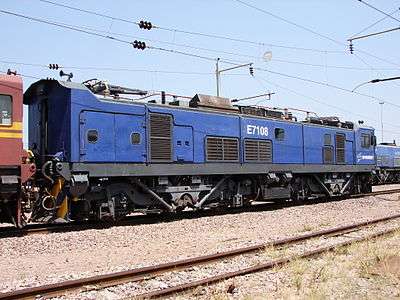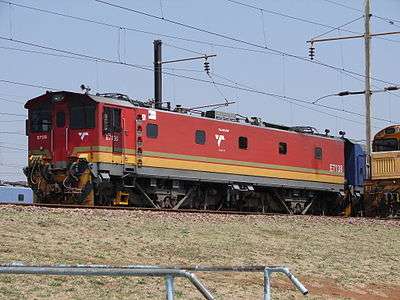South African Class 7E1
| South African Class 7E1 | |||||||||||||||||||||||||||||||||||||||||||||||||||||||||||||
|---|---|---|---|---|---|---|---|---|---|---|---|---|---|---|---|---|---|---|---|---|---|---|---|---|---|---|---|---|---|---|---|---|---|---|---|---|---|---|---|---|---|---|---|---|---|---|---|---|---|---|---|---|---|---|---|---|---|---|---|---|---|
|
No. E7111 at Vryheid, KwaZulu-Natal, 16 August 2007 | |||||||||||||||||||||||||||||||||||||||||||||||||||||||||||||
| |||||||||||||||||||||||||||||||||||||||||||||||||||||||||||||
| |||||||||||||||||||||||||||||||||||||||||||||||||||||||||||||
| |||||||||||||||||||||||||||||||||||||||||||||||||||||||||||||
| |||||||||||||||||||||||||||||||||||||||||||||||||||||||||||||
The South African Railways Class 7E1 of 1980 is an electric locomotive.
In 1980 and 1981, the South African Railways placed fifty Class 7E1 electric locomotives with a Co-Co wheel arrangement in mainline service.[1]
Manufacturers
The 25 kV AC Class 7E1 electric locomotive was designed for the South African Railways (SAR) by Hitachi, while Dorbyl in South Africa supplied the mechanical components. The first six locomotives, numbered E7101 to E7106, were built by Hitachi in Japan in 1979, while forty-four more were built by Dorbyl in South Africa between 1979 and 1981, numbered in the range from E7107 to E7150.[2][3]
Like Union Carriage and Wagon, neither Hitachi nor Dorbyl allocated builder’s numbers to the Class 7E1 locomotives they built for the SAR, but used the SAR unit numbers for their record keeping.[1]
Features
Appearance
Since they were acquired solely for use on the Richards Bay coal line where they would always work in multiple unit lashups, they were built with single cabs. Following the Class 9E which had entered service in 1978, the Class 7E1 was the second single cab mainline electric locomotive to be acquired by the SAR. Until the Class 9E was introduced in 1978, all South African mainline electric locomotives were dual cab units.[1]
The two sides of the Class 7E1 are sufficiently different in appearance that, when coupled end to end, a pair of them appears at first glance to be two different locomotive types. The left side is smooth, while the right has several large grilles.[1]
Pantographs
The locomotive's pantograph placement is unusual in not being equidistant from the locomotive ends. The contact shoe centre of the no. 1 end pantograph is 5,280 millimetres (17 feet 3.9 inches) from the longitudinal centre of the locomotive, while that of the no. 2 end pantograph is 6,250 millimetres (20 feet 6.1 inches) from the centre.[1]
Brakes
Control of traction and rheostatic braking on the Class 7E1 is by stepless solid-state electronics. The electrical equipment was designed for high power factor operation, obtained by the switching in of power-factor correction capacitors.[2]
Unlike the Classes 7E and 7E2, where thyristors are used, these locomotives use silicon-diode rectifiers.[4]
In the period from the early 1990s until about 2007, various modifications to improve downhill braking capacity were done to the Coalink line's Hitachi-designed locomotives. The first set of upgrades were done on the fifty Class 7E1 locomotives. They retained their Class 7E1 classification after modification.[2][3]
Bogies
Like the Class 6E1 and Class 7E, the Class 7E1 was built with sophisticated traction linkages on the bogies. Together with the locomotive's electronic wheel-slip detection system, these traction struts, mounted between the linkages on the bogies and the locomotive body and colloquially referred to as grasshopper legs, ensure the maximum transfer of power to the rails without causing wheel-slip by reducing the adhesion of the leading bogie and increasing that of the trailing bogie by as much as 15% upon starting off.[2]
Service
The Class 7E1 was placed in service on the 25 kV AC Ermelo-Richards Bay Coalink line, where most of them still work. By 2015 some had been transferred to Pyramid South.[2]
Liveries
All the Class 7E1 locomotives were delivered in the SAR Gulf Red livery with signal red cowcatchers, yellow whiskers and with the number plates on the sides mounted on three-stripe yellow wings. In the late 1990s many were repainted in the Spoornet blue livery with either outline or solid numbers on the sides and with a yellow and blue chevron pattern on the cowcatchers. After 2008 in the Transnet Freight Rail (TFR) era, several received the TFR red, green and yellow livery.[5]
Illustration
- No. E7137 in SAR Gulf Red and yellow whiskers livery at Vryheid, KwaZulu-Natal, 15 August 2007
 No. E7108 in Spoornet blue livery with solid numbers, Pyramid South, Gauteng, 22 September 2015
No. E7108 in Spoornet blue livery with solid numbers, Pyramid South, Gauteng, 22 September 2015- No. E7145 in Spoornet blue livery with outline numbers at Richards Bay, KwaZulu-Natal, 14 August 2007
 No. E7138 in Transnet Freight Rail livery, Pyramid South, Gauteng, 22 September 2015
No. E7138 in Transnet Freight Rail livery, Pyramid South, Gauteng, 22 September 2015
References
| Wikimedia Commons has media related to South African Class 7E1. |
- 1 2 3 4 5 South African Railways Index and Diagrams Electric and Diesel Locomotives, 610mm and 1065mm Gauges, Ref LXD 14/1/100/20, 28 January 1975, as amended
- 1 2 3 4 5 Paxton, Leith; Bourne, David (1985). Locomotives of the South African Railways (1st ed.). Cape Town: Struik. pp. 129–131. ISBN 0869772112.
- 1 2 Middleton, John N. (2002). Railways of Southern Africa Locomotive Guide - 2002 (as amended by Combined Amendment List 4, January 2009) (2nd, Dec 2002 ed.). Herts, England: Beyer-Garratt Publications. pp. 51, 61.
- ↑ Jane's Train Recognition Guide
- ↑ Soul of A Railway, System 7, Western Transvaal, based in Johannesburg, Part 9. South-Eastwards as far as Volksrust (2nd part) by Les Pivnic. Caption 4. (Accessed on 11 April 2017)